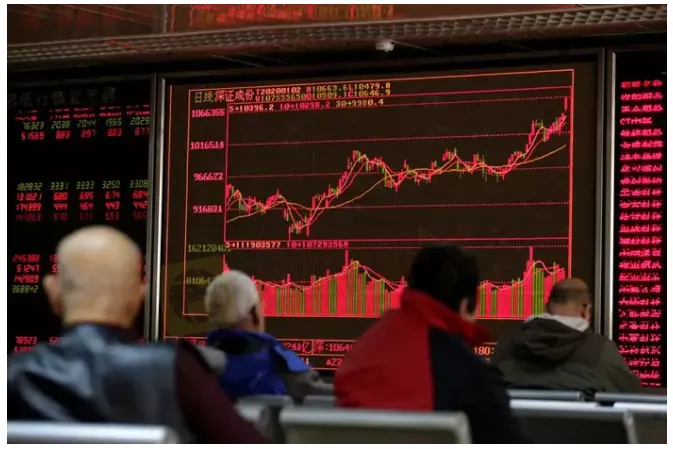简体中文
繁體中文
English
Pусский
日本語
ภาษาไทย
Tiếng Việt
Bahasa Indonesia
Español
हिन्दी
Filippiiniläinen
Français
Deutsch
Português
Türkçe
한국어
العربية
Oil leads mad rush to resources, stagflation a risk
Abstract:Asian shares crept higher on Thursday after reassuring comments from the Federal Reserve helped Wall Street rally, though the war in Ukraine sent oil and resource prices spiralling ever higher in a grim omen for global inflation.

Oil prices sped higher on Thursday as the war in Ukraine drove a mad dash for resources in an ominous sign for global inflation, while Asian shares eked out gains after reassuring comments from the Federal Reserve helped Wall Street bounce.
Brent crude topped $117 per barrel and is now up almost 20% on the week, while everything from coal to natural gas and aluminium are on fire as Western nations tighten sanctions on Russia.
“Russia supplies around 30% of Europes gas and oil imports and accounts for around 11% of world oil production,” said Shane Oliver, head of investment strategy at fund manager AMP. “In short, investors are worried about a stagflationary shock.”
The rush to commodities lifted resource-rich Australian stocks 0.9%, while Indonesia was just off a record high.
Japan‘s Nikkei managed a 0.8% gain, while MSCI’s broadest index of Asia-Pacific shares outside Japan nudged up 0.6%.
MSCI added to Russias financial isolation by deciding to exile the country from its emerging markets index, while FTSE Russell said Russia would be removed from all its indices.
Fitch slashed Russia‘s sovereign credit rating six notches to “junk” status, saying it was uncertain the country could service its debt, and Moody’s soon followed.
After bouncing overnight, S&P 500 stock futures were flat, while Nasdaq futures eased 0.1%.
EUROSTOXX 50 futures slipped 0.2%, and analysts at JPMorgan had a stark warning for clients.
“We believe investors should underweight the Euro area in both the currency and the equity space given its vulnerability to any further escalation,” they wrote in a note.
“We revised our commodity price forecasts 10-20% higher across the board given the unfolding geopolitical crisis,” they added. “One silver lining is that the crisis forced a dovish reassessment of the Fed by the market, and we continue to assume a ‘moderate’ hiking path.”
EURO UNDER PRESSURE
Fed Chair Jerome Powell on Wednesday said rates would likely be raised by only 25 basis points this month, and the war in Ukraine has made the outlook “highly uncertain”.
Futures reacted by pricing out any chance of a half-point hike later in March.
However, Powell did warn the Fed might have to hike more aggressively if inflation kept rising. That took some of the safe-haven steam out of Treasuries and 10-year yields were back at 1.85%, from Tuesdays two-month trough of 1.682%.
European bonds also surrendered some of their recent hefty gains after data showed euro zone inflation hit a record high of 5.8% in January, making it harder for the ECB to keep policy super loose.
Inflation was also on the mind of the Bank of Canada when it kicked of a tightening cycle on Wednesday with a quarter-point rate hike to 0.5%.
The move combined with the strength of oil prices to lift the Canadian dollar to a five-week high at $1.2625. Other commodity-linked currencies also benefited with the Australian dollar at a four-year peak on the euro.
The euro was likewise on the defensive at $1.1098, having carved out a 22-month trough overnight at $1.1056.
The dollar edged up to 115.68 yen as Japans trade position is set to worsen given it is a major importer of energy and resources.
Dealers stayed well away from the Russian rouble, though it did trade once at 101.00 per dollar. [FRX/]
The U.S. dollar index stood at 97.502, after reaching its highest since June 2020 at 97.834.
Gold was holding at $1,927 an ounce and still up 2% on the week so far thanks to safe-haven demand. [GOL/]
Oil flew further past $110 a barrel on talk the market will remain short of supply for months to come following sanctions on Moscow and a flood of divestment from Russian oil assets by major companies. [O/R]
Brent put on another $4.34 to reach $117.27 a barrel, while U.S. crude rose $3.32 to $113.92.

Disclaimer:
The views in this article only represent the author's personal views, and do not constitute investment advice on this platform. This platform does not guarantee the accuracy, completeness and timeliness of the information in the article, and will not be liable for any loss caused by the use of or reliance on the information in the article.
Read more

BOJ to Announce Policy Decision This Week, Market Bets on a Rate Hike
The yen strengthens past 156 as markets anticipate a rate hike from the Bank of Japan this week.

WikiEXPO 2025 is set to embark on a new global tour
WikiEXPO 2025 is set to embark on a new global tour First station - Hong Kong! Are you ready?

Will the Euro and US Dollar Reach Parity in 2025?
Euro-dollar parity sparks debate again as 2025 approaches, with multiple factors shaping the exchange rate outlook.

US Dollar Surge Dominates Forex Market
The global forex market continues to show volatility, with the U.S. dollar fluctuating last week but overall maintaining a strong upward trend. How long can this momentum last?
WikiFX Broker
Latest News
SquaredFinancial offers Trump & Melania meme coins
What is the Best Time to Trade Forex?
Win Rewards & Celebrate Lunar NY with JustMarkets
BBC World Service to axe 130 jobs in bid to save £6m
AI Fraud Awareness Campaign: "We're Not All F**ked"
Crypto.com Delists USDT and 9 Tokens to Comply with MiCA Regulations
How to Use Financial News for Forex Trading?
Fake ‘cyber fraud online complaint’ website Exposed!
Day Trading Guide: Key Considerations
GMO-Z com Securities Thailand to Cease Operations in 2025
Currency Calculator






